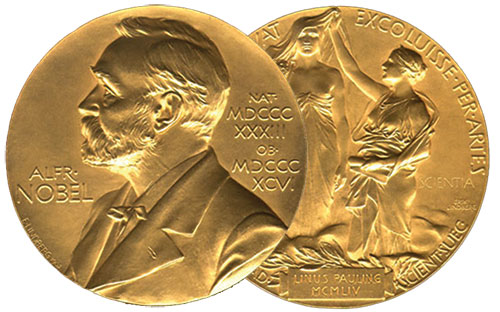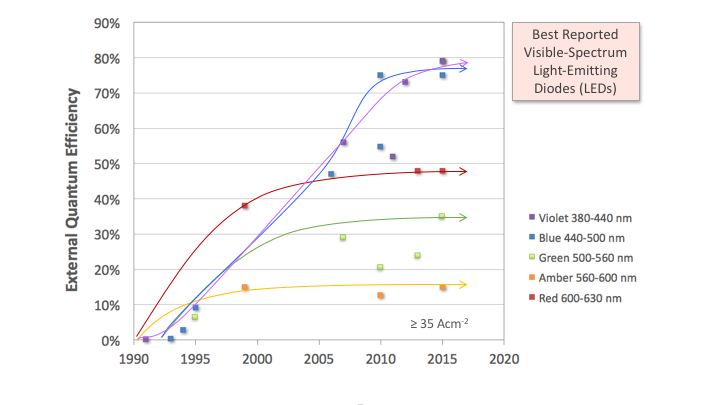
Do We Really Need Better LEDs?
A quarter of a century has transpired since the Nobel Prize winning work that delivered us commercially viable blue- (and thereby, white-) emitting LEDs. In the decades since, tremendous resource investment in gallium-nitride semiconductor based materials, devices, and packaging technologies has revolutionized backlighting for flat-panel displays (both large and small) and is now aimed at the general lighting industry, an approximate 100 B USD market transformation that promises a simultaneous reduction in worldwide electricity consumption of more than 10% [1].
What more is there to do? Indeed, maximum power conversion efficiencies of the most sophisticated blue-and violet-emitting LED chip architectures are nearing the theoretical limits [2]. Their light output is conveniently down-converted to longer wavelength (i.e., green/yellow/red) emission by available phosphors to every imaginable quality of white light, from the high-tech brilliance of an automobile headlight to the warm glow of an incandescent bulb. In addition, any shortcomings of existing phosphors are likely to be addressed by newer ones, or by the the emergence of quantum dots, a new semiconductor-based down-conversion technology that is already penetrating the large-area television market.
However, the down-conversion approaches come with a price: the energy of a blue or violet photon is significantly (about 20-30%) higher than that of green/yellow/red photons, and the associated conversion generates that much waste heat, even if the processes involved are 100% efficient (which they are not). Instead, using individual LEDs for each primary (e.g., red/green/blue) would eliminate the fundamental energy waste of the down-conversion approach, reduce rare earth material consumption, and also simplify LED application to color-tunable lighting and to display applications which currently require filters to convert white light into primary colors required for information visualization.
So, why aren’t multiple primary LEDs widely used today? The answer is efficiency. Unlike the case for blue- and violet-emitting LEDs, the performance of LEDs at longer emission wavelengths is fairly low and, even more worrying, has largely stagnated [3]. Indeed, the latest, best reported green-emitting LED efficiency is barely higher than it was a decade ago, and remains less than half as efficient as its blue- and violet-emitting counterparts. The situation for amber- and red- emitting LEDs is similar, and comprises a large part of the reason down-conversion materials like phosphors and quantum dots are developing into robust industries today.
Clearly, we do need better LEDs. The original inventor of the LED, Nick Holonyak, Jr., prophesied that LEDs of every imaginable wavelength would eventually be realized. However, today’s best performing gallium-nitride based LEDs largely employ the same technologies introduced 25 years ago. This has well served blue- and violet-emitting LEDs, but not nearly as much their longer wavelength counterparts. Evidently, a breakthrough is required and, as becomes more apparent day by day, one that will have to go beyond the Nobel Prize winning work from the 1980s and 1990s.
- “Energy Savings Forecast of Solid-State Lighting in General Illumination Applications,” Prepared for the U.S. Department of Energy by Navigant Consulting, Inc. (2014)
- C A Hurni, A David, M J Cich, R I Aldaz, B Ellis, K Huang, A Tyagi, R A DeLille, M D Craven, F M Steranka, and M R Krames, “Bulk GaN flip-chip violet light-emitting diodes with optimized efficiency for high-power operation,” Applied Physics Letters 106, 031101 (2015)
- M R Krames, 6-1: Invited Paper: Status and Future Prospects for Visible-Spectrum Light-Emitting Diodes, SID Symposium Digest of Technical Papers, 47, doi: 10.1002/sdtp.10594 (2016)

